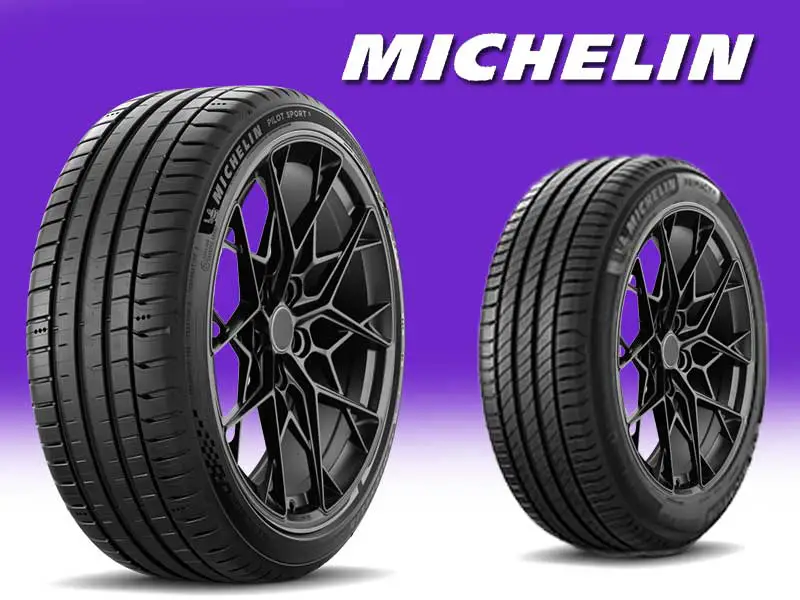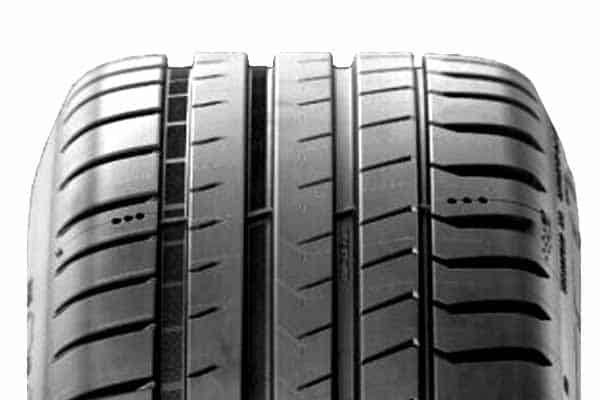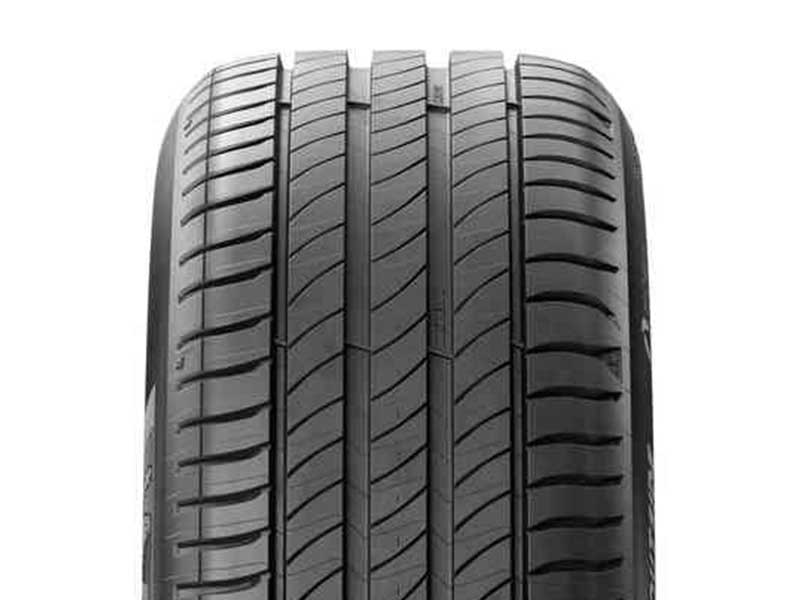When it comes to ultimate road performance during those scorching summer months, Michelin has provided two standout solutions with its new update. As now we have the Michelin Pilot Sport 5 and the Michelin Primacy 4+, and both of these tires are phenomenal in their own right, but how do they stack up against each other? Well, let’s find out.
To better understand their comparative performance, we need to first examine their sizes and specs, and then take a closer look at their unique tread designs.

| Specs | Michelin Pilot Sport 5 | Michelin Primacy 4+ |
|---|---|---|
| Sizes | 18 total sizes | 113 total sizes (16 to 20 inches rims) |
| Rim Sizes | 17 to 20 inches | 16 to 20 inches |
| Speed Ratings | Y only | H, V, W, and Y |
| Load Ratings | XL only | SL and XL |
| Tread Depth | 9/32″ | 10/32″ |
| Weight Range | 17 to 34 lbs | 16 to 30 lbs |
| Tread Mileage Rating | 30k miles warranty | No warranty |
Table of Contents
Tread Pattern
The Michelin Pilot Sport 5 is crafted with a distinctive asymmetric five-rib tread design. Here all its ribs are neatly arranged to create a total of four longitudinal grooves.
And adding to it’s overall asymmetric pattern, interestingly, three of these grooves share a consistent width, while the fourth groove is significantly narrower. (See the one on the right side, after shoulders).

All ribs in the middle run continuously, meaning they don’t form proper blocks, as you usually see on other tires.
And instead, you just see varying slits on all of them (in terms of their thickness and length).
These slits/cuts have dual functionalists, they act as sipes in wet conditions, and biters in dry.
Moving towards shoulders, these cuts become more prominent, and that goes especially for the ones on the right side of the tread (in the image above), where you see a more aggressive pattern.
Here slits are broader, which gradually narrow as they merge with the slender longitudinal groove whereas on the other side, the lateral grooves are narrower.
Moving towards the Michelin Primacy 4+, you get an symmetrical tread pattern here. Though there are similar 3 ribs in the middle, forming 4 circumferential channels.

Moreover, in a similar fashion, all these ribs are continuous running as well. They may seem to form blocks, but the cuts you see aren’t full depth.
But they still do act as sipes in wet conditions, and biters in dry, during braking, acceleration and cornering.
Same is the case with the shoulder lugs, where although you see aggressive cuts, they aren’t like that all the way deep.
Basically the tire’s tread is made out of two rubber layers of varying rigidity. And this allows for superior grip in different conditions.
Dry Performance
When evaluating dry performance, two key components have to be considered: grip and handling or lateral traction.
Grip
Grip, often referred to as directional grip, is primarily influenced by the central area of the tread, as that’s where the tread meets the road with greater friction (as it gets the most weight concentrations).
With this in mind, it’s not surprising that the Michelin Pilot Sport 5 with more closed up tread voids, and minimal tread features on all its ribs get to offer shorter braking distances, on average.
(Braking distance is the direct measure of directional grip, BTW).
On the other hand, the Michelin Primacy 4+ struggles to establish adequate contact with the road, mainly due to it’s excessive tread features, thereby resulting in an inferior grip compared to the Pilot Sport 5.
Lateral Traction
The overall handling capability of a tire is heavily dependent on its shoulders, as with cornering, they get the most weight distributions on them, due to inertia, you can say.
And in this regard, the Michelin Pilot Sport 5 is again taking the lead with its relatively larger shoulders, providing superior lateral traction values,( measured by g-forces).
In contrast, the Michelin Primacy 4+ has a softer compound, with greater tread depth, causing its lugs to bend a lot more, comparatively.
This leads to slightly delayed steering feedback, which can ultimately limit the tire’s handling capabilities.
Wet Performance
Wet traction comprises two vital aspects: wet grip and hydroplaning resistance.
Hydroplaning Resistance
In essence, hydroplaning is a condition, where a tire loses grip and glides or floats on a watery surface, with the thin layer of water formation between the road and the tread.
This scenario occurs when the tire’s grooves can’t effectively displace water, hindering direct contact of the rubber, which mostly occurs on higher speeds. That’s why it gets measured with, what they call “float speeds”, which represent the maximum speed a tire can attain (over standing water), before it begins to float.
Having said that, on both curved and straight aqua tests, the Michelin Pilot Sport 5 demonstrates superior float speeds. Despite having a tread depth of 1/32″ shorter than the Primacy 4+, it still offers better water evacuation capabilities, thanks to its wider longitudinal grooves.
Wet Grip
While most water is expelled from the tire through its grooves, contributing to hydroplaning resistance, the left-over water particles are managed by the tire’s sipes.
These sipes, offer slits in the tread, which temporarily hold water particles in, allowing the rubber to effectively meet up with the road. (As water is not compressible, that’s the only way, a tire can grip).
And in this regard, the Michelin Primacy 4+ excels.
Not only does it feature a greater number of sipes and biting edges across the tread, but its relatively softer tread compound also contributes to its superior performance as well.
This softer compound allows for increased flexibility of the sipes, allowing them to contract and expand more effectively, so that they can disperse residual water particles.
Fuel Usage
The Michelin Primacy 4+ is one of the most lacking tire (in its category), when it comes to fuel economy.
And this is because its lugs are more susceptible to bending, as the tire turns or brakes for example.
The tire’s softer tread compound and relatively greater tread depth both contribute to this excessive lug flexing.
As a result, more energy is expended in reshaping the lugs than in the actual rolling of the tire, leading to higher fuel consumption.
On the other hand, the Pilot Sport 5, with its stiffer compound and fewer biting edges, does the opposite, providing you with relatively superior fuel efficiency.
Tread Life
The Michelin Primacy 4+ although features a larger rolling resistance values, it’s overall treadwear is still saved due to its slightly larger tread depth.
Even though there’s only a difference of 1/32″, its still enough to allow this tire to have just as good of a tread life, as the Pilot Sport 5.
Moreover, the tire’s somewhat lighter weight is also helping it here.
Tread Noise
Noise is simply put, due to flow of air across the tread. The air particles basically hit around on the walls, and the impact is what causes the noise generation.
And although here, the Michelin Pilot Sport 5 isn’t a great tire, compared to other options out there, it still does better, when you consider the performance on Primacy 4+.
But why is that?
Well, mostly because of in-groove resonance, which is actually the echoing of the sound-waves inside the tread.
With softer tread compound, the Primacy 4+ simply produces more of that, rendering it one of the loudest tires out there (in its category).
To Sum Up
In order to evaluate the performance of these tires, we tested them out for several key factors including grip, handling, wet and dry traction, fuel efficiency, tread life, and noise levels.
On dry roads, the Pilot Sport 5 took the lead in both directional and lateral traction, while Primacy 4+ feel short in establishing sufficient road contact due to its excessive tread features, so it came out with longer braking distances and handling times.
Though the opposite happened on wet roads, where you see superior griping and handling on Michelin Primacy.
But in terms of hydroplaning resistance, which is also a crucial element of overall wet traction, the Pilot Sport 5 remained unbeatable.
Furthermore, for fuel usage, the Pilot Sport 5 is a better pick, with its lower number of biting edges. Whereas the Primacy delivers superior tread life.